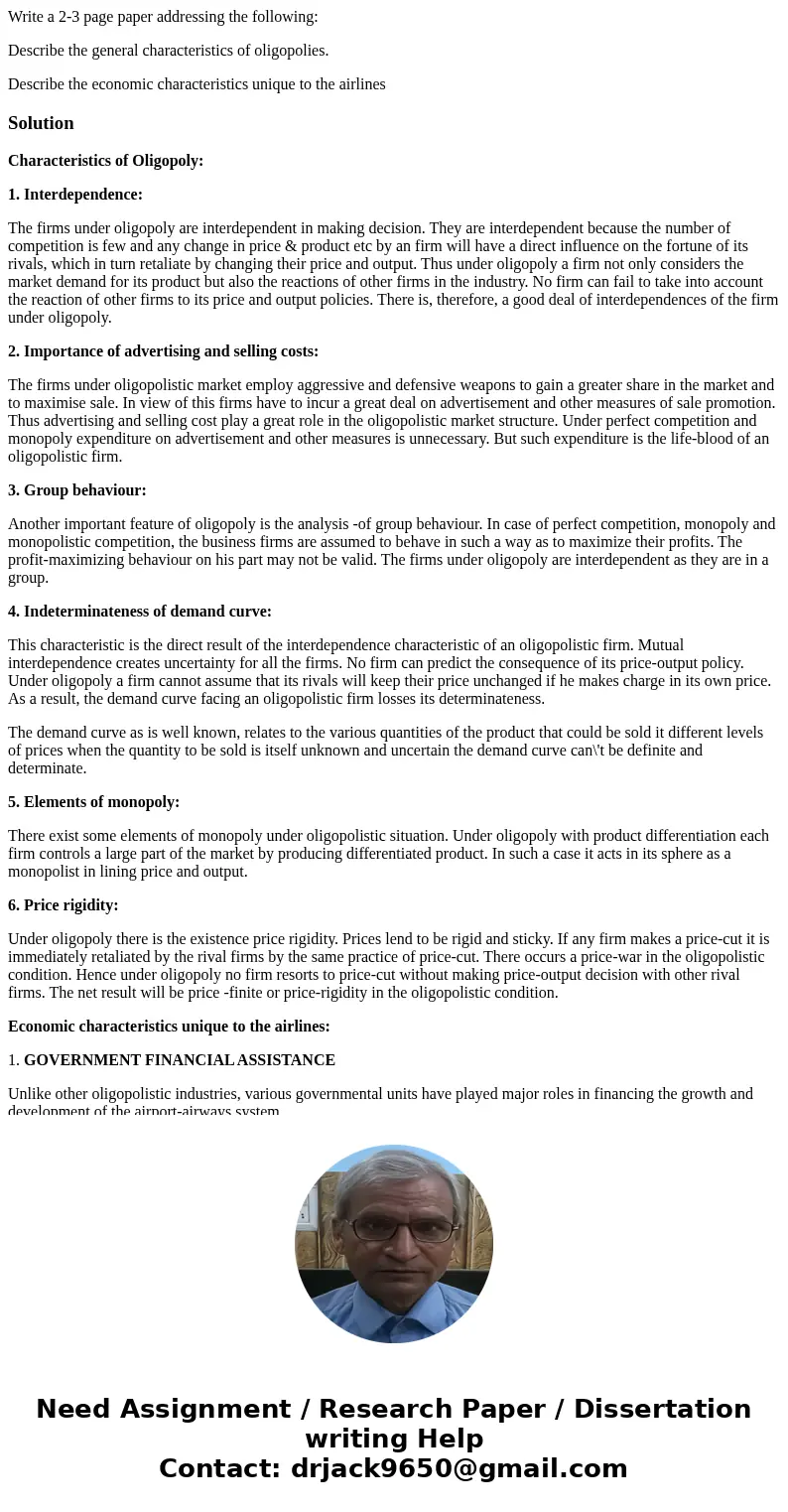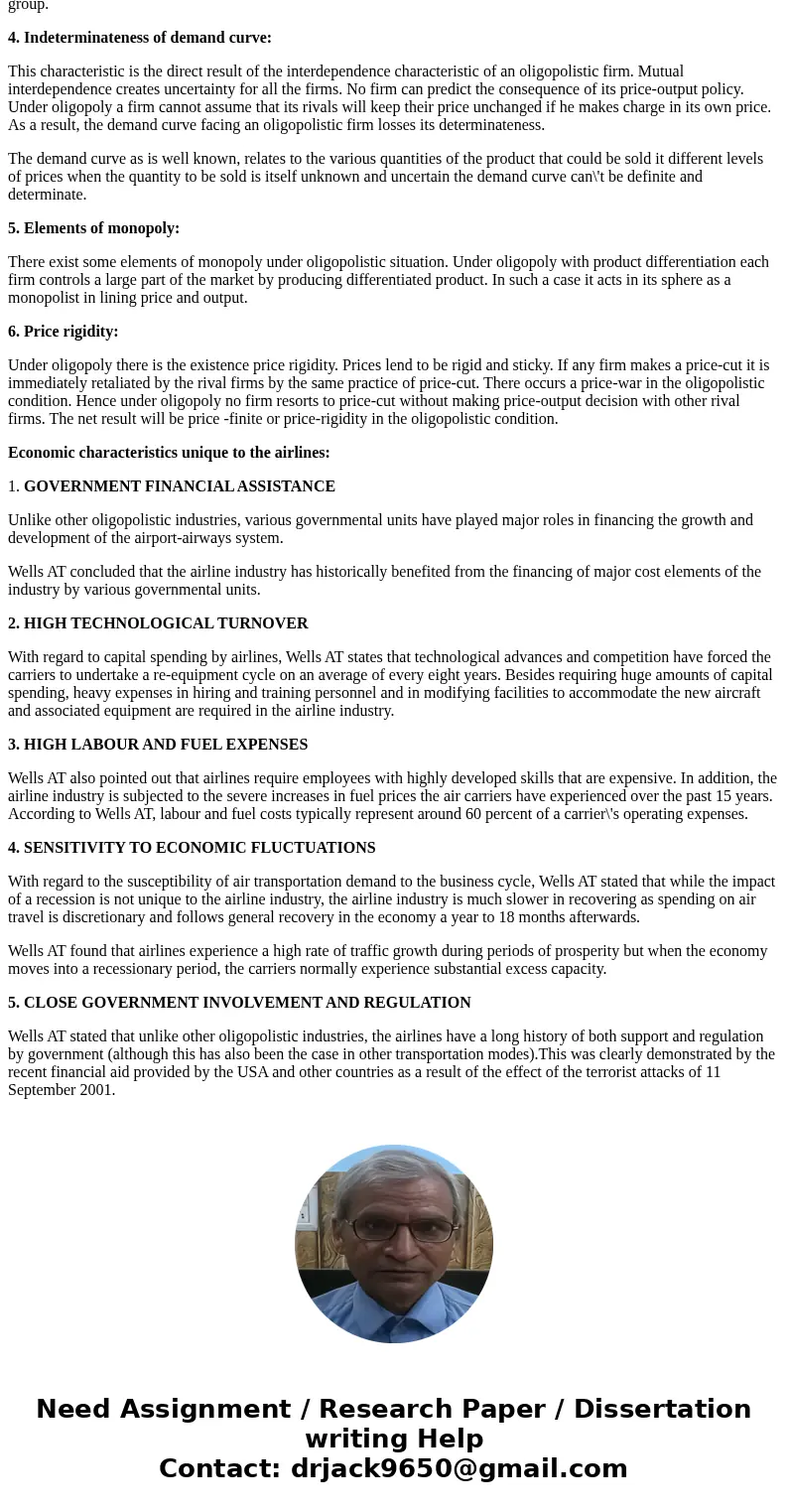Write a 23 page paper addressing the following Describe the
Write a 2-3 page paper addressing the following:
Describe the general characteristics of oligopolies.
Describe the economic characteristics unique to the airlines
Solution
Characteristics of Oligopoly:
1. Interdependence:
The firms under oligopoly are interdependent in making decision. They are interdependent because the number of competition is few and any change in price & product etc by an firm will have a direct influence on the fortune of its rivals, which in turn retaliate by changing their price and output. Thus under oligopoly a firm not only considers the market demand for its product but also the reactions of other firms in the industry. No firm can fail to take into account the reaction of other firms to its price and output policies. There is, therefore, a good deal of interdependences of the firm under oligopoly.
2. Importance of advertising and selling costs:
The firms under oligopolistic market employ aggressive and defensive weapons to gain a greater share in the market and to maximise sale. In view of this firms have to incur a great deal on advertisement and other measures of sale promotion. Thus advertising and selling cost play a great role in the oligopolistic market structure. Under perfect competition and monopoly expenditure on advertisement and other measures is unnecessary. But such expenditure is the life-blood of an oligopolistic firm.
3. Group behaviour:
Another important feature of oligopoly is the analysis -of group behaviour. In case of perfect competition, monopoly and monopolistic competition, the business firms are assumed to behave in such a way as to maximize their profits. The profit-maximizing behaviour on his part may not be valid. The firms under oligopoly are interdependent as they are in a group.
4. Indeterminateness of demand curve:
This characteristic is the direct result of the interdependence characteristic of an oligopolistic firm. Mutual interdependence creates uncertainty for all the firms. No firm can predict the consequence of its price-output policy. Under oligopoly a firm cannot assume that its rivals will keep their price unchanged if he makes charge in its own price. As a result, the demand curve facing an oligopolistic firm losses its determinateness.
The demand curve as is well known, relates to the various quantities of the product that could be sold it different levels of prices when the quantity to be sold is itself unknown and uncertain the demand curve can\'t be definite and determinate.
5. Elements of monopoly:
There exist some elements of monopoly under oligopolistic situation. Under oligopoly with product differentiation each firm controls a large part of the market by producing differentiated product. In such a case it acts in its sphere as a monopolist in lining price and output.
6. Price rigidity:
Under oligopoly there is the existence price rigidity. Prices lend to be rigid and sticky. If any firm makes a price-cut it is immediately retaliated by the rival firms by the same practice of price-cut. There occurs a price-war in the oligopolistic condition. Hence under oligopoly no firm resorts to price-cut without making price-output decision with other rival firms. The net result will be price -finite or price-rigidity in the oligopolistic condition.
Economic characteristics unique to the airlines:
1. GOVERNMENT FINANCIAL ASSISTANCE
Unlike other oligopolistic industries, various governmental units have played major roles in financing the growth and development of the airport-airways system.
Wells AT concluded that the airline industry has historically benefited from the financing of major cost elements of the industry by various governmental units.
2. HIGH TECHNOLOGICAL TURNOVER
With regard to capital spending by airlines, Wells AT states that technological advances and competition have forced the carriers to undertake a re-equipment cycle on an average of every eight years. Besides requiring huge amounts of capital spending, heavy expenses in hiring and training personnel and in modifying facilities to accommodate the new aircraft and associated equipment are required in the airline industry.
3. HIGH LABOUR AND FUEL EXPENSES
Wells AT also pointed out that airlines require employees with highly developed skills that are expensive. In addition, the airline industry is subjected to the severe increases in fuel prices the air carriers have experienced over the past 15 years. According to Wells AT, labour and fuel costs typically represent around 60 percent of a carrier\'s operating expenses.
4. SENSITIVITY TO ECONOMIC FLUCTUATIONS
With regard to the susceptibility of air transportation demand to the business cycle, Wells AT stated that while the impact of a recession is not unique to the airline industry, the airline industry is much slower in recovering as spending on air travel is discretionary and follows general recovery in the economy a year to 18 months afterwards.
Wells AT found that airlines experience a high rate of traffic growth during periods of prosperity but when the economy moves into a recessionary period, the carriers normally experience substantial excess capacity.
5. CLOSE GOVERNMENT INVOLVEMENT AND REGULATION
Wells AT stated that unlike other oligopolistic industries, the airlines have a long history of both support and regulation by government (although this has also been the case in other transportation modes).This was clearly demonstrated by the recent financial aid provided by the USA and other countries as a result of the effect of the terrorist attacks of 11 September 2001.


 Homework Sourse
Homework Sourse